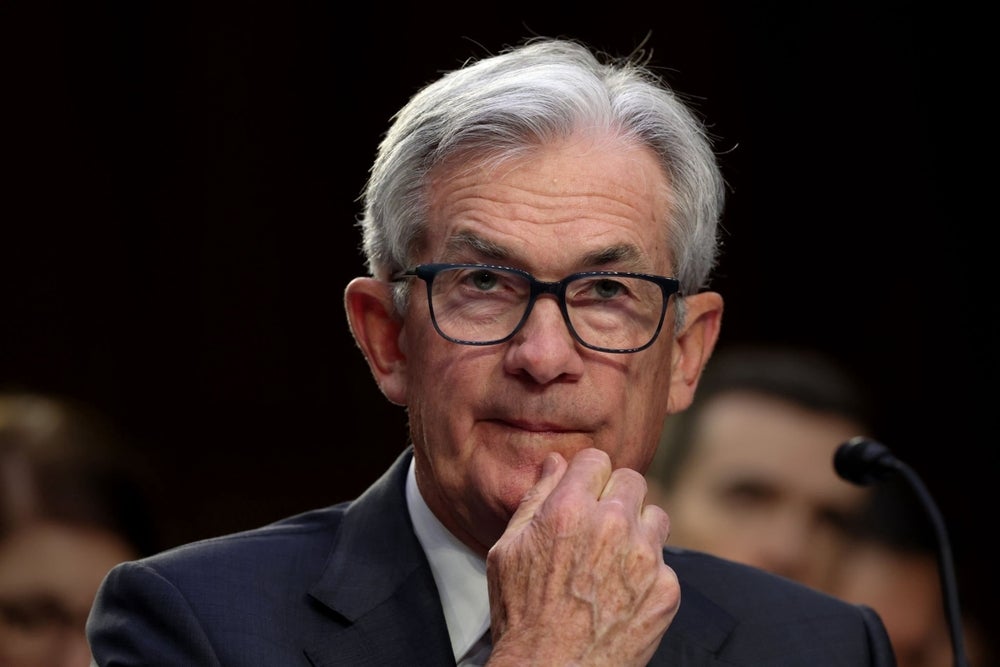Nathan’s Hot Dog Eating Contest 2021 was the highlight of my July 4th television viewing. I don’t know about you, but I find MLE (“Major League Eating”) to be a lot more entertaining than most organized sports these days, not least because it reminds me of what’s going on in the realm of major league central banking (“MLCB”).
JULY 04, NEW YORK, NY: On July… [+] 4, 2018, Joey Chestnut competes in the annual Nathan’s Hot Dog Eating Contest in the Coney Island district of Brooklyn, New York City. Chestnut took first place in the competition, devouring 74 hot dogs in ten minutes, a Coney Island record. (Photo courtesy of Getty Images/Eduardo Munoz Alvarez)
courtesy of Getty Images
Despite the fierce rivalry, I had my children switch off their electronic games to watch Joey Chestnut break his own world record of 75 hot dogs and buns in 10 minutes to win his 14th championship. For the mathematicians out there, that’s 7.6 DPM (dogs per minute). This is an incredible achievement in my opinion. As a card-carrying scientist, all I had to do was examine the techniques behind this astounding feat, and my research led me to documentary evidence of Takeru Kobayashi of Japan and Chestnut’s famed war for supremacy, which spanned over two decades.
I learned a little about the science behind rapid eating while viewing documentaries on the subject (here is a great link to some of the factoids). The geometric accuracy, pre-saturation by dunking, and every plate to mouth movement are all meticulously practiced and orchestrated, to say the least. There are times when the eater is about to vomit, yet a genuine champion can regurgitate even that! The sport is all about speed and volume, not eating in the way most mortals conceive of food. Simply put, a competitive eater’s physiological response differs significantly from that of a normal individual. A major league eater’s stomach, for example, increases 400 percent of its original size and does not trigger the STOP EATING NOW response that you or I would. I’d definitely gag in a few single digit count of hot dogs if pushed hard enough, but a champion eater can train to suppress this response.
The world’s four largest central banks are competing in their own hot dog eating contest, each attempting to set a new world record – no holds barred. We’re talking trillions of dollars in bonds consumed at a rate of hundreds of billions every month (BPM). They have become emboldened to inhale more and more bonds, in many cases by multiples of the outstanding net supply, led by economic dogma and ideology and empowered by surging asset markets.
As new, just-in-time ideas to defy the gravity of debt are rediscovered, the “science” and rhetoric evolve with the competition. The US Federal Reserve, for example, implemented flexible average inflation targeting (FAIT) to allow it to keep interest rates around zero while continuing to buy $80 billion in Treasuries and $40 billion in mortgage bonds even as stock, bond, and housing markets all hit new highs (Source: Federal Reserve). Not to be left behind, the European Central Bank has abandoned its inflation philosophy in favor of a whole new one that allows inflation to overshoot. The Bank of Japan, the reigning champion of competitive bond devouring, has a huge debt-to-GDP ratio and, for the time being, is also the reigning champion of government-sponsored stock purchases. Like the famed battle between Kobayashi and Chestnut, what the Japanese invented in terms of quantitative easing decades ago has now become a popular sport for other central bank competitors.
ADDITIONAL INFORMATION FOR YOU
I’m not allowed to discuss the aftermath of the hot dog eating contest in this topic. For most of us, the hot dog competition is an awe-inspiring act in and of itself, and we don’t want to know what occurs next. However, only a few web searches yield lurid and horrific details (search for videos by one “Furious Pete”). Fortunately, the bond gorging’s aftermath is likewise predictable, albeit (slightly) less nefarious in its features.
Even while MMT (modern monetary theory) argues there is no such limit unless there is inflation, the vast quantity of debt that has been accumulated and swallowed by central banks will have to be disgorged at some time, and no one knows when. This can happen in one of three ways. The simplest, and most disruptive, way is for central banks to stop swallowing new bonds or even consider selling their existing holdings. They don’t stop buying bonds in the second way, but they do indirectly cause the currency in which the bonds are denominated to depreciate. They exchange their bonds for other assets in the final approach. The first method leads to a rise in yields and a drop in prices from the standpoint of markets. Other asset classes, such as equities, profit from the flows out of bonds in the second strategy, while the third approach results in competitive devaluation of currencies. In all three circumstances, it’s difficult to justify bond holdings as long-term investments. Please download a free copy of my recently published CFA Institute Research Foundation monograph on the upside-down bond market for an in-depth explanation of today’s bond market ecology and the role of central banks (here).
Let me remind you that there are competitive eating contests for hard boiled eggs, pizzas, tacos, cow brains(! ), lemonade, and anything else you can think of. Some central banks have already moved on to the next phase of asset purchases. For quite some time, the BOJ has been purchasing equities ETFs (Source: BOJ). The Federal Reserve and the European Central Bank have already expressed an interest in purchasing corporate bonds. It’ll only be a matter of time before they all begin competing in these other competitions. Why not, if asset purchases have no negative implications all of the time?
So, given the continued battle among central banks to acquire assets, what is the best approach for investors? First and foremost, as the event organizers have warned, “don’t do this at home.” Professionals should compete in hot dog speed eating and bond gorging events. Take my word for it: trying to beat Joey Chestnut at hot dog eating before the competition begins is foolish. But, after he’s set the world record (currently at 76 HDB – hot dogs and buns) and won the competition, it might be worth challenging him to a competition for a half-dozen more. Even if one loses the competition, the odds appear to be much greater. In the bond markets, I believe we are approaching the same stage. Central banks are poised to declare triumph, and those who attempted to fight them have surrendered. Even while they continue to buy bonds, several central banks have already begun to shift toward a tighter monetary policy outlook. Timing is crucial in the markets, just as it is in hot dog eating, and the greatest time is when the champ is loaded to the gills./n

/https://specials-images.forbesimg.com/imageserve/60e75323b3eff9117eca0980/0x0.jpg)



